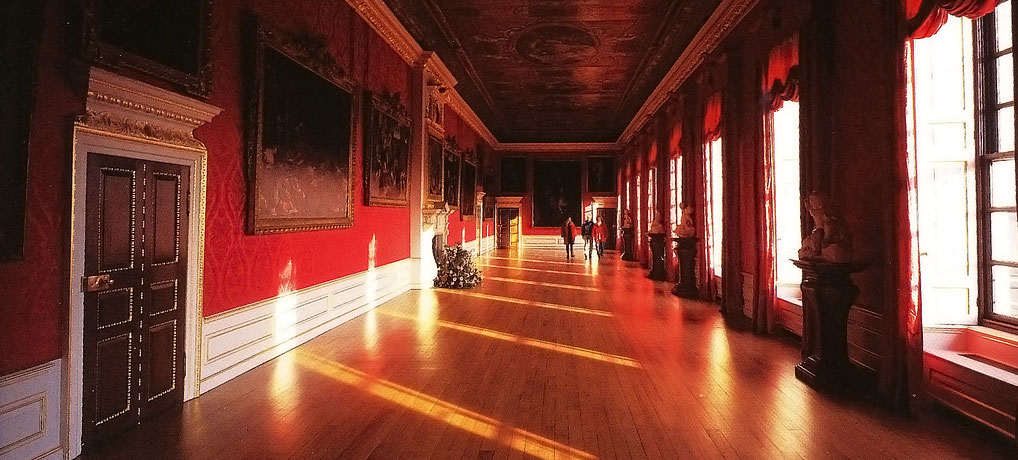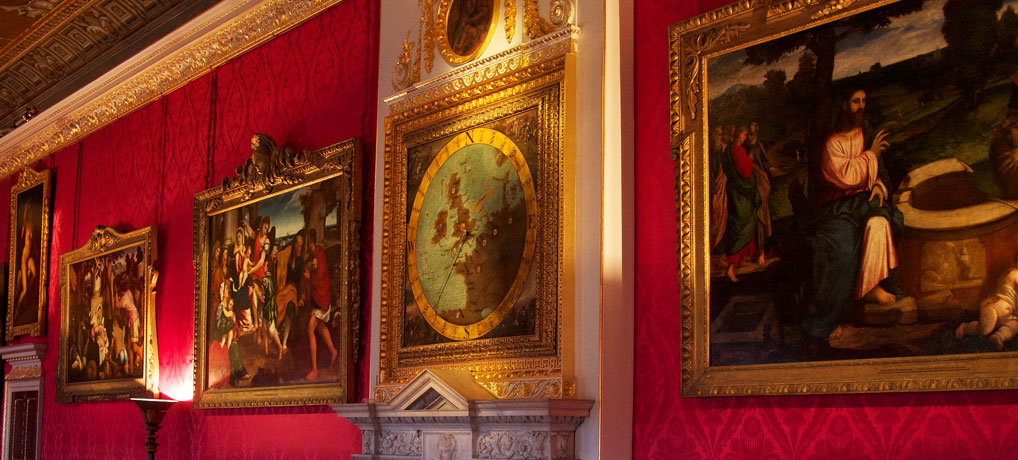
The palace has been described as a “plain brick building, of no particular style or period, but containing a heterogeneous mass of dull apartments, halls, and galleries, presenting externally no single feature of architectural beauty; the united effect of its ill-proportioned divisions being irregular and disagreeable in the extreme.” This criticism can hardly be considered too severe. Certain portions of the exterior, it is true, are admired as fine specimens of brickwork in their way; but it cannot be concealed that the general effect of the brick is mean and poor.
The great staircase, of black and white marble, and graceful ironwork (the walls painted by Kent with mythological subjects in chiaroscuro, and architectural and sculptural decoration), leads to the suite of twelve state apartments, some of which are hung with tapestry, and have painted ceilings. The ‘Presence Chamber’ has a chimney-piece richly sculptured by Gibbons, with flowers, fruits, and heads; the ceiling is diapered red, blue, and gold upon a white field, copied by Kent from Herculaneum; and the pier-glass is wreathed with flowers, by Jean Baptiste Monnoyer. The ‘King’s Gallery,’ in the south front, has an elaborately painted allegorical ceiling, and a circular fresco of a Madonna, after Raphael. ‘The Cube Room’ is forty feet in height, and contains gilded statues and busts, and a marble bas-relief of a Roman marriage, by Rysbrack. The ‘King’s Great Drawing-room’ was hung with the then new paper, in imitation of the old velvet flock. The ‘Queen’s Gallery,’ in the rear of the eastern front, continued northwards, has above the doorway the monogram of William and Mary; and the pediment is enriched with fruits and flowers in high relief and wholly detached, probably carved by Gibbons. The ‘Green Closet’ was the private closet of William III., and contained his writing table and escritoire; and the ‘Patchwork Closet’ had its walls and chairs covered with tapestry worked by Queen Mary.”

The palace contains a comfortable though far from splendid or tasteful suite of state apartments, the ceilings and staircases of which are ornamented with paintings by Kent. The grand staircase leads from the principal entrance to the palace, on the west, by a long corridor, the sides of which are painted to represent a gallery crowded with spectators on a Court day, in which the artist has introduced portraits of himself; of “Peter, the Wild Boy;” of Ulric, a Polish lad, page to George I.; and of the Turks Mahomet and Mustapha, two of his personal attendants, who were taken prisoners by the Imperialists in Hungary, and who, having become converts to Christianity, obtained posts at Court.
The chapel royal is as plain and ordinary an apartment as a Scottish Presbyterian would wish to see; but it is remarkable for containing some fine communion plate. Divine service is performed here regularly by a chaplain to the household, and the public are admitted.
The palace has a character of its own among the other residences of the royal family. Leigh Hunt hits the right nail on the head when he speaks of it as possessing “a Dutch solidity.” “It can be imagined full of English comfort,” he adds; “it is quiet, in a good air, and, though it is a palace, no tragical history is connected with it; all which considerations give it a sort of homely, fireside character, which seems to represent the domestic side of royalty itself, and thus renders an interesting service to what is not always so well recommended by cost and splendour. Windsor Castle is a place to receive monarchs in; Buckingham Palace, to see fashion in; Kensington Palace seems a place to drink tea in; and this is by no means a state of things in which the idea of royalty comes least home to the good wishes of its subjects.”
